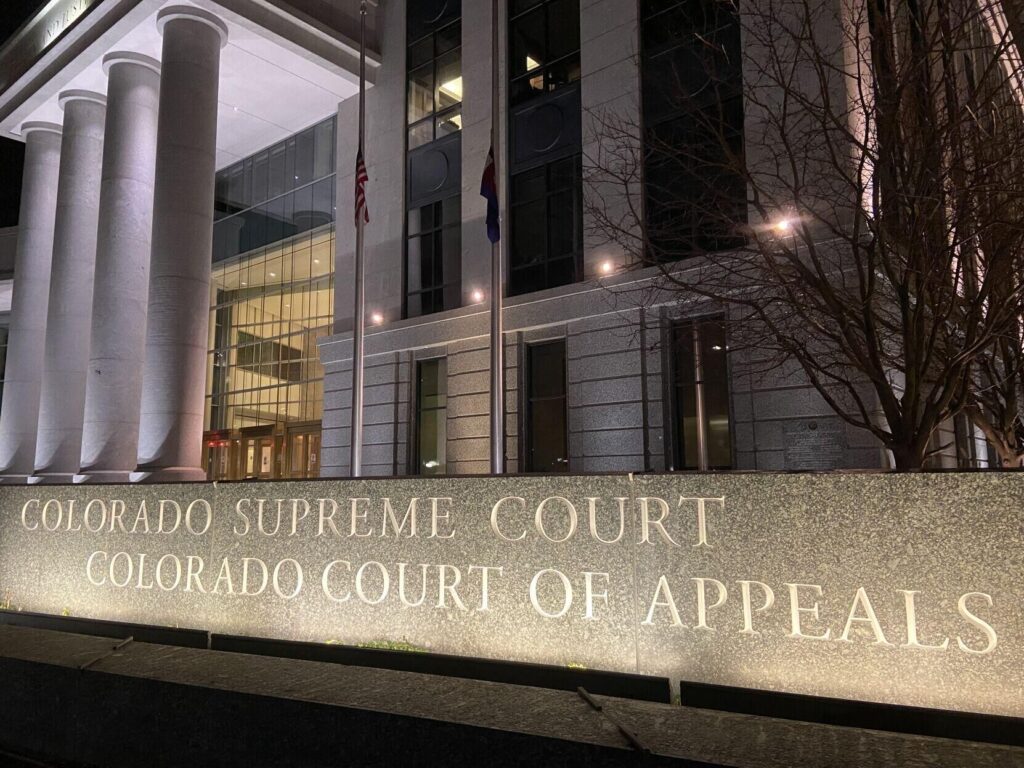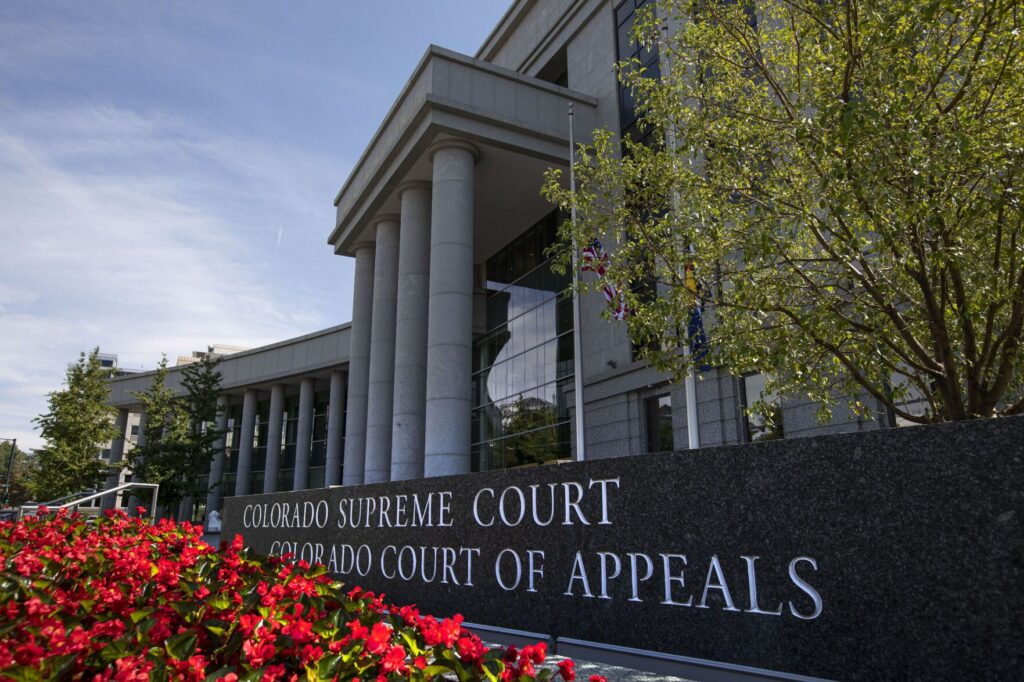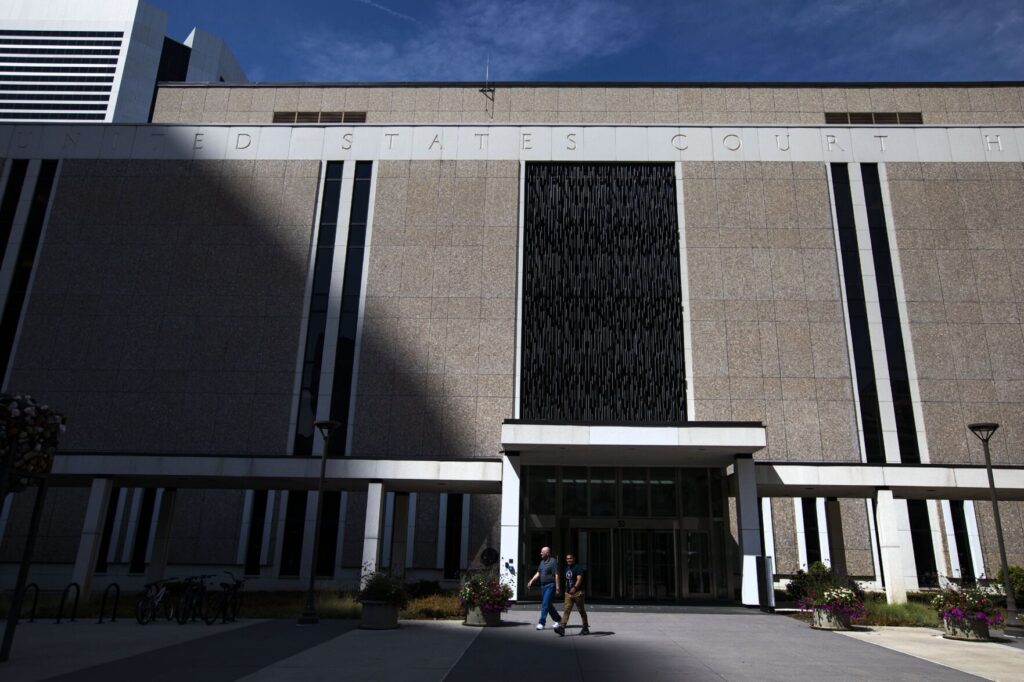Colorado justices hear arguments on Jeffco slip-and-fall, man’s pursuit of bike thief

Members of the Colorado Supreme Court on Thursday considered whether the state law that broadly shields the government from civil lawsuits applies to upgrades of public parking garages, raising the possibility of cities and counties being increasingly on the hook for personal injury claims in the future.
The justices also heard a second case questioning the degree to which criminal defendants are liable for damage caused during their flight from a crime scene, and how closely appellate judges should scrutinize the sequence of events.
The court held oral arguments at Gateway High School in Aurora as part of the judiciary’s 37-year-old Courts in the Community program. Twice per year, the justices travel outside of downtown Denver to hear actual cases in front of students and members of the public. After each argument, the students had the opportunity to ask questions of the attorneys.

In the first appeal, Beverly Stickle originally sued Jefferson County for injuries she sustained on the upper level of a parking garage at the Jeffco Administration & Courts complex in February 2018. At the top landing was a dark gray walkway, with a step-down to the car lot – recently repainted the same color of gray. The change in elevation was marked by yellow paint, which was most evident when looking from the lot toward the landing.
From the walkway, however, the identical grays created an illusion, masking the step-down. Stickle fell and suffered a compound fracture in her right arm.
In response to Stickle’s lawsuit, Jeffco invoked the Colorado Governmental Immunity Act, which broadly shields public entities from civil liability. There is an exception to the immunity, however, for injuries caused by the “dangerous condition of any public building.” A dangerous condition cannot simply be due to poor design, but rather the negligent construction or maintenance of the building.


The county argued its parking garage was not a “building” and the resurfacing of the parking lot that created the illusion was not “maintenance.”
The state’s Court of Appeals disagreed.
“The undisputed facts establish that this topping material was added as part of the Maintenance Plan for the parking structure,” wrote Judge Anthony J. Navarro last July.
On appeal to the Supreme Court, the county insisted its parking garage was not a building but simply a “structure.”
“How would you define ‘building?'” asked Justice William W. Hood III.
Assistant Deputy County Attorney Rebecca P. Klymkowsky argued a building has the “capacity to contain,” providing shelter for people, animals or property. The county headquarters adjacent to the garage was the building, she explained, but not the freestanding garage.
“What do you do with the fact that it was required to comply with the building code?” said Justice Richard L. Gabriel about the garage.
“Leave it to lawyers and judges to struggle with the meaning of ‘building,'” Justice Carlos A. Samour Jr. quipped.
Multiple outside entities filed briefs in support of Jeffco, including associations representing cities, counties and special districts. By calling the resurfacing of the parking garage “maintenance,” instead of a redesign or an upgrade, the Court of Appeals created a deterrent to local governments upgrading their infrastructure for fear of lawsuits, they argued.
The Court of Appeals “effectively transformed any improvements that could make the facility last longer into maintenance,” added the State Office of Risk Management.
Some of the justices, however, pointed out Jeffco did not originally argue the resurfacing of the parking garage was a design improvement, rather than maintenance. Moreover, there was a concern about insulating governments from liability whenever they upgrade existing infrastructure.
“Anytime an agency does maintenance, if they decide to use material that’s better than the original,” said Samour, “that means there’s gonna be immunity every time. ‘We used a different material because five years have gone by and the material is better.’ All you’re doing is maintenance. I worry about the slippery slope.”
After the arguments, in response to student questions, Klymkowsky disclosed the county had since fixed the step-down illusion where Stickle fell.
“Even if we don’t have a legal duty, we don’t want people to get hurt,” she said.
The case is County of Jefferson v. Stickle.

In the second appeal, a Boulder County judge ordered Arnold Roman Martinez to pay $2,394 for the damage to his victim’s car. Martinez stole a bicycle from the victim’s garage and rode away, but the victim reacted quickly enough to give chase. Driving alongside Martinez, the victim turned in front of him, causing Martinez to crash the bicycle into the car.
Colorado’s restitution law requires judges to consider financial compensation criminal defendants may owe their victims for injuries caused by their conduct. The Court of Appeals agreed the decision by Martinez’s victim to turn in front of him to cut off his escape was a foreseeable consequence of the bike theft.
“It defies logic to claim that, once the victim’s car was parallel to Martinez, the victim would simply back off and allow Martinez to speed away on the victim’s $6,000 bicycle,” wrote Judge Lino S. Lipinsky de Orlov.
Before the Supreme Court, Martinez’s attorney argued it was actually the victim’s fault that Martinez damaged the car.
“The law shouldn’t encourage these kinds of vigilante acts of property recovery when they endanger other people,” said public defender Meredith K. Rose.

Justice Melissa Hart pointed out, however, that this was not a case in which a vehicle ran a stop sign and collided with Martinez, completely unrelated to his criminal offense.
“He hit the car because he stole the bike and the bike’s owner was chasing him and pulled in front of him,” she said. “These are all things related to each other.”
On the other hand, the justices suggested that chasing a criminal suspect and causing unanticipated damage might not be attributable solely to a defendant.
What if the victim “had hit the side mirrors of a number of other cars because he was trying to get to the bike? Is that something to seek restitution for?” Hart wondered.
“If it’s foreseeable that you might try to cut somebody off,” Hood pressed, “why isn’t it equally foreseeable that you might seriously injure or kill a person?”
Martinez also advocated for the Supreme Court to allow appellate judges broad leeway to review the evidence behind restitution orders, rather than narrowly looking at whether trial judges made a clear error or abused their discretion.
The case is Martinez v. People.













